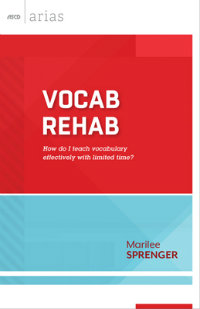Quick, Effective Ways to Teach Vocabulary
Vocab Rehab: How Do I Teach Vocabulary Effectively With Limited Time?
By Marilee Sprenger
(ASCD Arias Imprint, 2014 –Learn more)

Few will argue with the importance of building and expanding student exposure and comprehension to content-related vocabulary. The difficulty arises with the ever-dwindling resource of time, or, more specifically, the lack of minutes in a class period that we can dedicate to the practice of vocabulary instruction.
While teaching vocabulary takes only a few minutes, true comprehension requires time. What’s a teacher to do?

From the opening vignette through four short sections covering the three tiers of vocabulary development – direct vocabulary instruction, vocabulary diversity and vocabulary and classroom conversations – Sprenger builds teacher background knowledge on vocabulary the same way that successful teachers increase student background knowledge on unfamiliar concepts.
The beginning third of the text wraps up in the What the Research Says chapter with a succinct list of three current, research-based practices every teacher can employ tomorrow in the classroom to deepen student vocabulary usage and knowledge.
The next section, Vocab Rehab: An Introduction, lays the foundation for the strategies Sprenger provides in the following two chapters by proposing a solution to the issue of time: vocabulary can be effectively, efficiently and engagingly taught in ten-minute increments.
Research corroborates her claim, and a promising list of ten instant, no-prep vocabulary-strengthening activities, like ‘draw a picture depicting a [vocabulary] word’ and ‘share synonyms and antonyms for words,’ is provided. These 10 are in addition to the 17 she provides and describes in-depth later in the book.
Sensitive to different instructional settings
One of my complaints in instructional texts for educators is the detailed explanation of a new strategy, system or instructional practice without taking into consideration that the teachers reading the text may have class times and school or classroom structures that differ greatly from what the author presents as the ideal. Nothing is more defeating than trying to cram a new, fresh strategy into a structure where it doesn’t fit and not being given reflective ways to encourage success.
Fortunately, before launching into the Vocab Rehab Strategies, Sprenger pauses to ask readers to do just that: think through the process of adding short vocabulary activities to an already-busy class and consider what non-crucial content currently being taught can be removed to make way for meaningful vocabulary activity. She adds 11 more tips to consider at the beginning stages of adding vocabulary instruction.
Thoughtful (and fun) guidance
The Vocab Rehab 10 -Minute Strategies section is the heart of the text. Ten minutes is the suggested minimum time of student engagement, and some of the strategies, like Getting to the Point with PowerPoint, require preparation, but each of the activities appeals to a different type of learner and varying levels of student vocabulary knowledge. And, let’s be honest, they just look fun!
Empowering students through vocabulary comprehension opens doors and fosters a deeper connection between students and the content we want them to learn. Sprenger proves that it isn’t only the quantity of vocabulary exposure that makes the difference, it’s also the quality. And with her guidance, explicit instruction and thoughtful research, teachers are 10 minutes from making that a reality.
Beth Morrow is a freelance writer, blogger, veteran middle school ESL teacher and workshop presenter in Columbus, Ohio, who has been writing about education, politics, health issues, summer camp and the business of writing for over two decades. Her work has appeared in a variety of magazines, newspapers and blogs around the world. She provides educational and classroom resources at her blog, www.canwejustread.com, and tweets with educators @BethFMorrow.



































